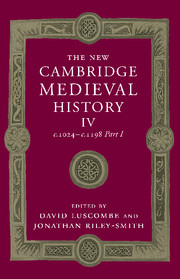Book contents
- Frontmatter
- 1 Introduction
- 2 The Rural Economy and Demographic Growth
- 3 Towns and the Growth of Trade
- 4 Government and Community
- 5 The Development of Law
- 6 Knightly Society
- 7 War, Peace and the Christian Order
- 8 The Structure of the Church, 1024–1073
- 9 Reform and the Church, 1073–1122
- 10 Religious Communities, 1024–1215
- 11 The Institutions of the Church, 1073–1216
- 12 Thought and Learning
- 13 Religion and the Laity
- 14 The Crusades, 1095–1198
- 15 The Eastern Churches
- 16 Muslim Spain and Portugal: Al-Andalus and its Neighbours
- 17 The Jews in Europe and the Mediterranean Basin
- 18 Latin and Vernacular Literature
- 19 Architecture and the Visual Arts
- List of Primary Sources
- Bibliography of secondary works arranged by chapter
- Index
- Frontispiece">
- Plate section"
- References
3 - Towns and the Growth of Trade
Published online by Cambridge University Press: 28 March 2008
- Frontmatter
- 1 Introduction
- 2 The Rural Economy and Demographic Growth
- 3 Towns and the Growth of Trade
- 4 Government and Community
- 5 The Development of Law
- 6 Knightly Society
- 7 War, Peace and the Christian Order
- 8 The Structure of the Church, 1024–1073
- 9 Reform and the Church, 1073–1122
- 10 Religious Communities, 1024–1215
- 11 The Institutions of the Church, 1073–1216
- 12 Thought and Learning
- 13 Religion and the Laity
- 14 The Crusades, 1095–1198
- 15 The Eastern Churches
- 16 Muslim Spain and Portugal: Al-Andalus and its Neighbours
- 17 The Jews in Europe and the Mediterranean Basin
- 18 Latin and Vernacular Literature
- 19 Architecture and the Visual Arts
- List of Primary Sources
- Bibliography of secondary works arranged by chapter
- Index
- Frontispiece">
- Plate section"
- References
Summary
The two centuries that opened with the decline of Córdoba and closed with the sack of Constantinople in 1204 were ones of vigorous development in European commerce and urban life. Change was apparent throughout a territory measuring some 4000 km from the Volga to Ireland by some 3200 km from Scandinavia to the southern shores of the Mediterranean, which was characterised by a wide range in material conditions and in the forms of urban culture inherited from earlier times. Local variation was considerable, but there is much to be gained from considering the phenomenon as a whole, despite the fissures artificially imposed by subsequent national and historiographical traditions. Moreover, the towns and trade of Europe were in this as in other periods subject to strong influences from outside: from the Middle East and North Africa, and from trading networks which fed into those regions from much further away.
During the eleventh and twelfth centuries most of Europe was distinctly backward and peripheral by comparison with areas south of the Mediterranean and in the Middle East, which were highly commercialised and urbanised and under Muslim control. This was an important influence on patterns of trade, and it was to be half a millennium before that relationship was conclusively reversed. Nevertheless, at the beginning of the period most parts of Europe were urbanised to some degree, in that they contained settlements which we can describe as towns, where there were relatively large numbers of inhabitants dwelling in close proximity and making a living predominantly from specialised crafts, exchange and other services rather than from agriculture.
Keywords
- Type
- Chapter
- Information
- The New Cambridge Medieval History , pp. 47 - 85Publisher: Cambridge University PressPrint publication year: 2004
References
- 5
- Cited by

